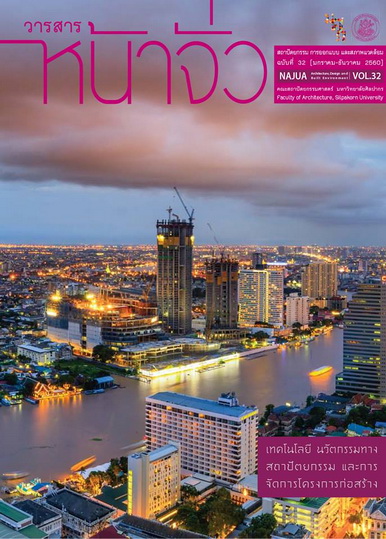ร่องรอยความเป็นมอญภายใต้รูปลักษณ์ของเรือนโคราช: บ้านพระเพลิง ปักธงชัย นครราชสีมา
Keywords:
เรือนโคราช, มอญ, บ้านพระเพลิง, ปักธงชัย, นครราชสีมา, โคราช, Ruean Korat, Mon, Ban Phra Phloeng, Nakhon Ratcha SimaAbstract
“นครราชสีมา” หรือ “โคราช” เป็นเมืองที่มีความสำคัญทางประวัติศาสตร์มาตั้งแต่อดีตจนกระทั่งปัจจุบันโดยไม่เคยร้างลาผู้คน จึงทำให้เป็นพื้นที่ที่การตั้งถิ่นฐานของผู้คนนานาชาติพันธุ์ อย่างไรก็ดี ประชากรกลุ่มหลักในพื้นที่คือ กลุ่ม “ชาวไทโคราช” ซึ่งเอกลักษณ์ทางวัฒนธรรมที่มีลักษณะเฉพาะตัว รวมทั้งสถาปัตยกรรมพื้นถิ่นที่อยู่อาศัยที่เรียกว่า “เรือนโคราช” ซึ่งมีลักษณะทางสถาปัตยกรรมที่สะท้อนให้เห็นถึงความสัมพันธ์ระหว่างเรือนไทยภาคกลางกับเรือนอีสาน จากการศึกษาที่ผ่านมามีการเก็บข้อมูลรูปแบบทางสถาปัตยกรรมของเรือนโคราชในพื้นที่ต่างๆ ในจังหวัดนครราชสีมา ทั้งนี้พบว่า พื้นที่ที่ยังปรากฏมีเรือนโคราชมากที่สุด คือ บ้านพระเพลิง ตำบลนกออก อำเภอปักธงชัย
ทว่าในการศึกษานี้ได้ลงสนามบันทึกข้อมูลเรือนโคราชที่บ้านพระเพลิง ตำบลนกออก อำเภอปักธงชัยนั้นได้พบข้อมูลที่น่าสนใจว่า ชุมชนบ้านพระเพลิงเป็นชุมชนมอญที่เคลื่อนย้ายเข้ามาตั้งถิ่นฐานอยู่ในโคราชตั้งแต่สมัยกรุงธนบุรีและสมัยรัตนโกสินทร์ตอนต้น ซึ่งยังมีผู้สืบเชื้อสายมอญ ซึ่งสืบทอดขนบธรรมเนียมประเพณีของชาวมอญอยู่ในชีวิตประจำวัน ตลอดจนคติความเชื่อต่างๆ
ในที่นี้ จึงมีข้อเสนอว่า “เรือนโคราช” ในสถานภาพการรับรูนั้น เป็นการอธิบายถึง “ลักษณะทางกายภาพ” หรือหมายถึงสิ่งที่เป็น “รูปธรรม” ของสถาปัตยกรรมเรือนพื้นถิ่นที่อยู่อาศัยซึ่งเป็นสิ่งห่อหุ้มเนื้อแท้ภายในของกลุ่มคนต่างๆ ไว้ภายใน รวมทั้งผู้มีสายเลือดมอญและตลอดจนวิถีชีวิตไว้ภายในสิ่งห่อหุ้มดังกล่าว ทั้งนี้ ในอดีตอาจมีเหตุผลในแง่ของการซ่อนเร้น “อัตลักษณ์ทางชาติพันธุ์ที่แตกต่าง” ไปจากชนหมู่ใหญ่ที่ตั้งถิ่นฐานอยู่ในพื้นที่ หรือที่เรียกว่าเป็น “อัตลักษณ์ปิด” ทว่าต้องการสำแดงความเหมือนหรือเป็นเนื้อเดียวกัน หรือ “อัตลักษณ์เปิด” ผ่านการแสดงออกด้วยรูปแบบทางสถาปัตยกรรมของเรือนโคราช หรืออาจจะเป็นเพราะความนิยมอันแพร่หลายของรูปแบบของเรือนไทโคราชจนส่งผลต่อเนื่องมายังการก่อสร้างบ้านเรือนของชาวมอญด้วยรูปแบบของเรือนไทโคราชก็เป็นไปได้ทั้งสองแนวทาง อย่างไรก็ตามร่องรอยของความสัมพันธ์ดังกล่าวก็คงปรากฏหลงเหลืออยู่บ้างในทางกายภาพ และจากข้อมูลที่ได้รับจากความทรงจำของผู้ทรงคุณวุฒิในท้องถิ่น
Trace of of Mon’s Identities under the Form of Korat’ House: Ban Phra Phloeng, Pakthongchai, Nakorn Ratcha Sima
Sarawut Dhammaratanasin
Master of Arts Program in Vernacular Architecture, Faculty of Architecture, Silpakorn University
Nakhon Ratchasima or Korat is well-known as a historical and multi-cultural province in Thailand due to the settlement of various ethnic groups there since ancient times. The exchange of different cultures developed a unique citizen group known as Korat. “Choa Thai Korat” is a Thai citizen group with their own unique characteristic spoken language, culture, tradition, food, costume, traditional entertainment, music and vernacular architecture. “Ruean Korat” or Korat Vernacular House is a unique combination between Vernacular House from central Thailand and Vernacular House from the east of Thailand. Following much research of the “Ruean Korat”, there are a number of collective data bases which indicate that the Ruean Korat were built in various locations over the province. The highest number of Ruean Korat is at Ban Phra Phloeng Nok Ok Sub District, Pak Thong Chai District. Based on the history of Nakhon Ratchasima, Ban Phra Phloeng (Phra Phloeng Village) was the ancient Mon Village.
According to field study of Ruean Korat at Ban Phra Phloeng in Nok Ok Sub District, the ethnic Mon group emigrated to Korat during the time of the Thonburi Kingdom (1768 – 1782) and the early period of the Rattanakosin Kingdom. Descendants of the Mon have lived in the village since and continue to preserve their unique culture.
Interestingly, the well-known vernacular style of Ruean Korat reflected “Physical characteristic” or “Tangible” of architecture. The housing vernacular was only “outermost shell” which covered the Mons’ personal preferences. However, there were perhaps hidden reasons about “the differences of ethical characteristic” from the major ethic group in the same area which can be called “Closed Characteristic”. The unique closed characteristic however attempt to show the similarity or “Opened Characteristic” through vernacular architecture of Ruean Korat. According to these, the popularity of Ruean Korat or Ruean Thai Korat architecture style perhaps influenced the ethic Mon group house in regards to “Closed Characteristic” and “Opened Characteristic”. But at the present, the evidence of relationship is only shows in some physical element of the case study and the memory of the peoples who are the key person of this study





